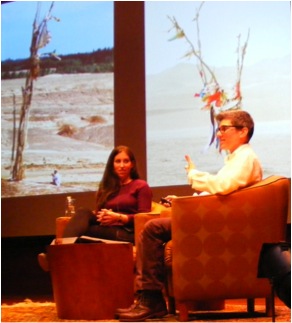Mazar Shrine Book Launch Details State Control Cautiously

February 20, 2013
Greg Fay, Manager, Uyghur Human Rights Project
Photographer Lisa Ross spent eight years studying and photographing mazar, Uyghur religious shrines, across East Turkestan, and the resulting images can be seen in a new book, Living Shrines of Uyghur China. Ross spoke at a book launch at the Rubin Museum in New York last week, which will host an exhibition also titled Living Shrines of Uyghur China from February 8-July 13, 2013 featuring Ross’s photographs, videos and an interactive viewing station.
Also released as a podcast, Ross spoke at the launch with Rubin Museum Assistant Curator Beth Citron about the mazar and her endeavor to capture the spiritual atmosphere of the sites. Mazar are often located in remote areas, many of which are currently off limits to foreigners. Ross described traveling across East Turkestan visiting the sites with a Uyghur-speaking historian, Alexandre Papas, using a guide written by local anthropologist, Rahile Dawut. Later, Ross traveled with Dawut herself, learning more about communities of worship around the mazar and also instructing Dawut’s students in photography to augment their anthropological study of mazar. Essays by Citron, Papas and Dawut are all featured in the book.
Asked about Chinese repression of Uyghur religious practice, Ross mentioned a major pilgrimage to the Ordam Mazar that was closed down. In her essay, Dawut writes that this was one of the largest and most important annual pilgrimage sites until it was banned. Papas describes other ways of keeping out Uyghurs of mazars including regulating the sites by charging prohibitive entrance fees and requiring personal information be recorded in a registration book. He also describes strengthening of official controls and regulations around mazar after alleged attacks on Chinese security in August 2008, details of which UHRP reported in 2008 were “strictly controlled by Chinese authorities.” Foreign reports cast doubt on one of the attacks as the New York Times reported in September 2008.
The ban on the Ordam pilgrimage occured in 1997, over two decades before the 2008 crackdown. In the essay “Mazar festivals of the Uyghurs: Music, Islam and the Chinese State,” Rachel Harris and Rahile Dawut trace the history of repression of the mazar festivals. First banned under the PRC in 1958 following the national anti-Rightest campaign, the festivals were revived after the Cultural Revolution in 1976. Policy toward the festivals in the 1990s became caught up in fears of Islamic fundamentalism, leading to the 1997 Ordam ban. China’s policies toward the mazar festivals have varied locally. For example, the Imam Hasim Mazar festival in Khotan, another major festival, has been regulated by the government since 1997, but not banned.
Ross herself was cautious with authorities. After unrest in 2008 led to a tense security situation, Ross said she would knock over her tripod whenever someone would pass by so they would not know she was videotaping the site. Yet despite what Citron describes in her essay as Ross’s choice to remain apolitical, Citron also writes that through her photographs, “Ross nevertheless captures attempts of the Chinese government that threaten to turn these living shrines into relics or tourist sites.” Indeed, Ross was able not only to document an incredible collection of images and teach photography to students in East Turkestan, but also draw attention to a Uyghur practice that is largely unfamiliar to the outside world and particularly vulnerable to state repression.
More of Ross’s work can be seen on her website. Her mazar photography was also the focus of an exhibition at the University of California, Berkeley last year.
